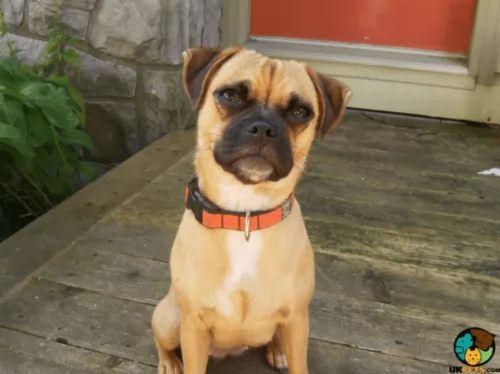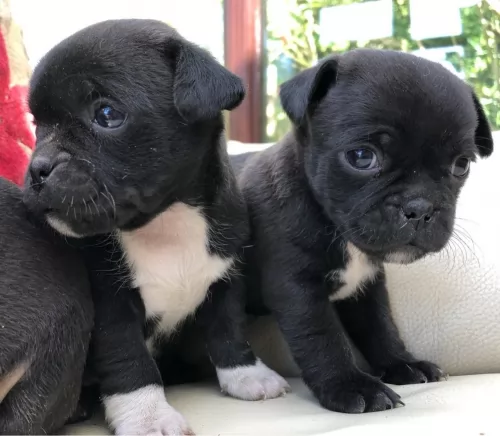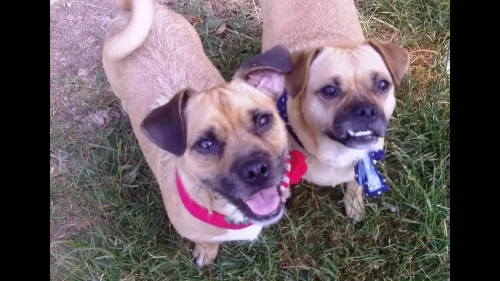 MyDogBreeds
MyDogBreedsJug is originated from United Kingdom but Beagador is originated from United States. Jug may grow 24 cm / 9 inches shorter than Beagador. Jug may weigh 11 kg / 24 pounds lesser than Beagador. Both Jug and Beagador has almost same life span. Both Jug and Beagador has almost same litter size. Jug requires Low maintenance. But Beagador requires Moderate maintenance
 The Jug is a crossbreed – a mix of a pug and a Jack Russell Terrier and they were bred in England with the idea to keep the basic features of a pug but just with a longer nose.
The Jug is a crossbreed – a mix of a pug and a Jack Russell Terrier and they were bred in England with the idea to keep the basic features of a pug but just with a longer nose.
Details on the origin of the dog are not altogether clear but the dog was developed so that it would reduce the breathing problems that pugs and other flat-faced breeds are known for.
This isn’t an old breed and development started around the 1960s. It is one of the most recent breeds to be registered by the American Canine Hybrid Club.
The Beagador, the gorgeous medium size dog, is a mix of two beautiful breeds: Labrador retriever and a Beagle. This mix was made on purpose in the USA and resulted in a breed that got all the best of both breeds. The Beagador is an intelligent dog, very good in sports and very sociable. This made him very popular around the globe and one of the most desirable dog pets.
 The Jug will usually end up having a round head with the typical short muzzle of the Pug. He may be somewhat lighter in build than the Pug, taking more after the Jack Russell in this regard.
The Jug will usually end up having a round head with the typical short muzzle of the Pug. He may be somewhat lighter in build than the Pug, taking more after the Jack Russell in this regard.
The way the dog turns out will depend on which dog the puppy takes after. He is a small breed dog standing at between 25 to 36cm at the withers and weighing 5 to 7kg.
When it comes to coat color you'll find they can vary between fawn, black, apricot and sometimes a blend of two colors. While pugs come with smoothish coats, the Jack Russell can either have a smooth or rough coat and your Jug could inherit either a smooth or rough coat.
He could inherit the Pug’s flat, somewhat wrinkled face while others may have a slightly longer muzzle. The eyes are large and the ears are floppy. The legs are short and the tail will no doubt be left long these days and be slightly curled.
The tenacious, fearless, intelligent nature of the Jack Russell Terrier mixed with the entertaining, amicable nature of the pug has brought out the Jug dog with a whole lot of excellent qualities of both dog breeds.
They are loving, loyal dogs and when they are trained and socialized they get on particularly well with both pets and children in the the home. He is intelligent and will be able to learn some simple commands such as sit, stay and lie down.
The Beagador got his height genes from the Beagle. That means that he is a bit shorter than the Labrador. Generally, they look a lot more like the Labrador, but in some cases, the puppies actually look more like a Beagle. So, actually, there is no rule about this. They have the short coat, usually very smooth. Sometimes it turns out softer and sometimes it doesn’t. They come in many colours, and they are usually two-coloured. So, the real truth is that Beagador breed appearance depends on the stronger genes between parent mix of Beagle and Labrador.
 Jugs are wonderful little dogs and they make a good choice for first time dog owners as they don’t come with any difficult characteristics.
Jugs are wonderful little dogs and they make a good choice for first time dog owners as they don’t come with any difficult characteristics.
They’re playful, intelligent, energetic and amicable and just love to please their human family. Because of his small size, he is also an adaptable dog, being able to settle down in the city or the country, as long as he is given enough mental- and physical exercise to prevent boredom and frustration.
Provide the right environment for your Jug and you’ve got an awesome canine friend for life.
The Beagador is a friendly breed. They will make no difference between adults and children, and they will bond easily even with complete strangers. But, children are usually more active than adults, so, in situations where he can choose, he will definitely choose to play with children. Some say that this dog never grows up in his heart. Maybe that is the reason they like children more.
Hunting, sports
The Beagador has the sweetest temper. But, for him, everything is a game. He might be a little bit too happy for other dog breeds. He likes to chase, jump, wrestle and be very physical with other animals. Some animals will enjoy this, but most of them won’t. If you start training him while he is still a puppy and socializing him from his early days, he will learn how to fit in and take a break once in a while.
The Beagador is very intelligent breed. They will be easy to train but only if you are experienced teacher. If you are not, they will try to get the things on their own way and you will end up being trained. It is advisable to use the reward technique, but make sure you don’t prise your Beagador with food. Early training is a must.
 Your jaunty little Jug can live anything from 12 to 20 years when looked after well.
Your jaunty little Jug can live anything from 12 to 20 years when looked after well.
Just like with any other dog however, he can become ill, and then you will need to get him to the vet as soon as possible. Allergies, breathing problems, bloat, primary lens luxation, skin disorders, deafness, cardiomyopathy and obesity are just some of the common dog diseases that your Jug might have to deal with.
Because one of the dogs used in the development of the Jug is a Pug, as a brachycephalic breed, they could suffer with breathing problems. The Jug which inherits the shorter muzzles can suffer from a condition known as Brachycephalic Airway Syndrome.
Some Jugs can have the large, protruding or bulbous eyes of the Pug. With an eye problem known as Entropion, the lid of the eye can turn inward so that the eyelash pushes into the eyeball, causing lots of redness, discharge and irritation. This can lead to an infection in the eye. You may notice your Jug constantly pawing at his eye.
This can be a real problem for your Jug and the extra weight will put additional strain on the dog’s heart and other organs and also affect his overall health and wellbeing.
The problems with their third eyelid, high risk of corneal wounds since they get too playful all the time, a disease that causes the dysfunction of the tear glands, conjunctivitis, glaucoma, cataracts, blindness.
When the puppies are born with skeletal defects that causes them to remain small.
Atopic dermatitis – very dry skin. If not treated, it will result in wound made by scratching the itchy and dry skin.
Since they have dropped ears, they don’t have the natural airflow and that causes the most of the infections.
 Small he may be, but the Jug is an energetic little dog who will require exercising to keep him content. Toys to chew on are good and you can take him for walks too. Throw a ball for him or let him tug on a rope.
Small he may be, but the Jug is an energetic little dog who will require exercising to keep him content. Toys to chew on are good and you can take him for walks too. Throw a ball for him or let him tug on a rope.
To keep your little Jug healthy and happy, you want to be sure that his diet is made up of a balanced mix of vitamins and minerals. If you feed him a commercially manufactured food, make sure that its one of the best ones free of toxic colorants and preservatives.
Check on the packaging for portion sizes for your pet. Give him some home-made food too such as cooked chicken, rice, pasta and vegetables and try to also include some raw meat mixed into his kibble from time to time. Fresh, cool water should always be included day and night.
With healthy food, your Jug can make it to 17, 18, 19 or 20 years of age even. Remember that anytime you get a pet, you can check with your veterinarian for dietary recommendations.
The Jug can shed quite a bit, particularly if he inherited more of the Pug coat. Make sure you brush his coat at least twice a week to rid him of loose hairs. Brushing also strengthens the bond between you and your pet.
Recognize the signs of an ear problem. These can be redness or swelling, ear scratching, head shaking or ear discharge.
To keep his teeth and gums healthy you can provide him with safe, appropriate toys to chew on as well as dental chews recommended by your vet.
Check your dog’s eye health. Signs of an eye problem are eye discharge and redness. Take your pet to the vet as soon as possible and try and remove hair around the eye that could be causing irritation.
One of the first things you will notice is – you will never be able to feed your Beagador. He is always hungry, and he can always have just one more bite. But, this usually leads to very dangerous obesity. Make sure you feed him with prescribed portions: three times a day until he is 6 months old, and two times per day once he grows up. Their diet must be sugar-free.
The Beagador is one of the lovable breeds. They need a lot of love and they show a lot of love. They have playful nature and they get happy just by being with people. They shouldn’t be left alone for too long because they will easily develop the separation nervousness. They like to eat and they will use any chance to beg for food. That makes them very obese in no time. Keep in mind that giving them the prescribed proportion is for their own good. They need moderate grooming since they shed regularly. If you bathe them once in a month and brush them two times per week, they will do just fine.
The Beagador is a very active dog. They need daily activity. Since they are very friendly, you will have a great chance to meet a lot of people at the dog park! They will run with you, run along while you drive your bike, play in the water, fetch.